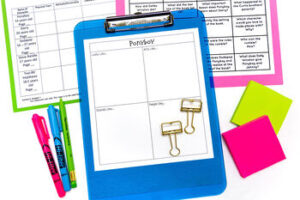Hello, fellow science educators! Are you looking for ways to improve your classroom management skills? Just like we unveil the mysteries of science to our students, I’ll reveal secrets to creating a positive and engaging classroom environment. Get ready to add some extra sparkle to your teaching toolkit with these 5 awesome behavior strategies. From turning “uh-oh” into “aha!” to making teamwork as seamless as a chemical reaction, we’re about to explore strategies that will make our science classrooms the coolest labs of learning and fun!
Improving Classroom Management with Positive Reinforcement
Carefully chosen words
The words we use with our students can help to provide positive reinforcement. While it may seem simple, carefully crafted phrases can significantly impact classroom management.
Phrases can include:
- You should be proud of yourselves, scholars. Now this is ___th grade level work as we get ready for (next grade).
- I see that (student’s name) is focused and working on the assignment.
- Thank you, ______, for working on the assignment.
Need ways to acknowledge students with challenging behaviors? Try some of these phrases:
- (Student’s name), I saw you working really hard/staying on task/etc.
- (Student’s name), I appreciate your effort.
- (Student’s name), I see lots of positive changes.
- (Student’s name), I’m proud of you/You should be proud of yourself.
Use the student’s name to really personalize your message. It will show the student and others in the classroom exactly what you recognize. This will help students to become ready to accept positive reinforcement.
Positive Notes and Calls
Aside from giving immediate feedback in the classroom, contacting parents about positive moments in your classroom can go a long way.
Most students are used to parents being contacted for negative circumstances, so turn it around and let students know that you will take the time to contact parents for positive experiences!
This personalized recognition boosts the student’s confidence and fosters a positive connection between teachers and parents.
It is also nice to quickly jot down what you contacted home about and let the student know. Sometimes, students aren’t aware of the positive call or email, so make sure they know by following up with a short note for the student!
Timely Feedback on Assessments
While I do not think EVERYTHING needs to be graded, if you give students an assessment such as a test or quiz, grade them in a timely manner so that they can reflect on their hard work.
Whether students do well or not, it is easier to put in effort when they know it is needed. Taking weeks to get back a test grade after you’ve moved on to another unit or several units is not helpful feedback.
Giving students timely feedback on assessments can help increase positive classroom behaviors by allowing them to seek help if needed or see that their hard work paid off.
Use Stickers as Positive Reinforcement
Students of all ages love stickers and stamps, so use them in your classroom. Stickers can give students instant feedback to let them know when they are
- doing the right thing, have asked a thoughtful question,
- tried their best,
- succeeded in understanding a hard concept.
Some stickers and other small items that my students LOVE:
- Smelly stickers – the worse the smell, the more they love them
- Science stickers – make sure you flip through these before students see them. 98% are perfect for kids, but there are usually one or 2 that are not really school appropriate in my eyes
- Chicken erasers – My students love these! They look like real pieces of chicken but can be used as erasers!
- Squishies
Build Relationships
The best way to increase positive reinforcement and improve classroom management is by forming relationships with your students. Knowing your students interests will allow you to better relate to them. They will feel like they are being listened to and will want to perform well for you. Some quick ways to form relationships with your students:
- Quick question of the day – not related to school but something that gets to know them. Would You Rather questions are perfect when you are short on time.
- Wall of Positivity: Dedicate a small area of your classroom where students can use post its to share personal or classroom wins!
- Student clothing – Try to make connections based on clues that they give you. Are they wearing a school jersey? Ask them about the team they are on. Wearing a shirt from a movie or band you know? Tell them something related to it so that they know you see them!
- Lessons – Try to include lessons that will help you learn more about the students. Lessons like Elements of Me or My Atomic Life help to sprinkle SEL in with science. Now you can learn a little bit more about the student!
So, fellow science trailblazers, there you have it – 5 incredible strategies to light up your classroom like a star-filled night sky! By infusing positivity, building relationships, and connecting with home, you’re not just managing behavior – you’re cultivating a vibrant haven of curiosity and growth. Remember that these strategies aren’t just tools; they’re the magical ingredients that make learning sparkle and flourish. So go ahead, embark on this adventure armed with the power of positive reinforcement, and watch as your classroom transforms into a place where every student’s potential shines brighter than a supernova! Happy teaching, science champs!







